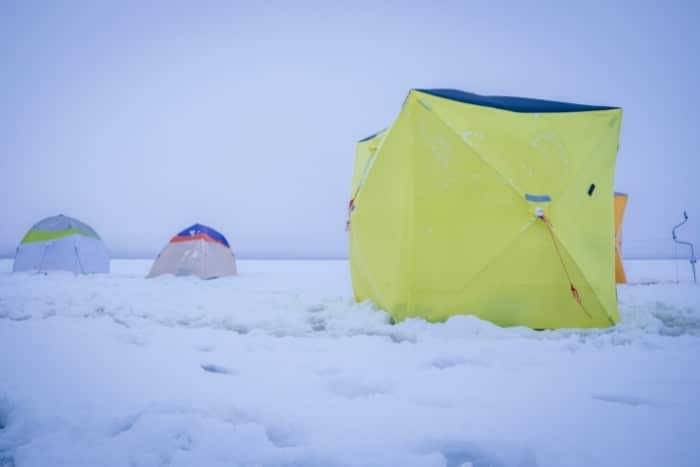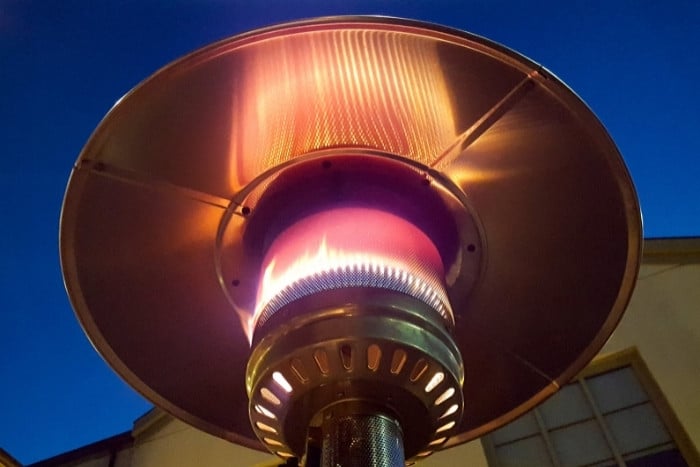In a day and age where people desire more and more creature comforts during their outdoor activities, ice fishing has seen some of the most advancements in modern amenities! At the top of the list is determining the best ways to keep ice anglers warm while spending hours and hours on the water. While heaters are an obvious tool, companies have worked harder and harder to improve their ice shelters.
Ice fishing tents can keep you warm. Depending on the style of tent you’re using, and whether it’s insulated or not, you’ll notice a difference in temperatures as soon as you step inside. An ice fishing tent with no heater won’t keep you comfortable, but it’ll stop the wind and precipitation.
Ice fishing tent features have come a long way in the past two decades, and anglers can easily find a setup that suits them and their needs.
Ice Fishing Tent Materials
Ice fishing tents are designed mainly to keep out any inclement weather. A quality tent will have fabric to keep out precipitation and built-in insulation that keeps the heat in longer.
From there, it’s up to the angler to find a heat source.
1. Outer Materials
When you’re looking to make your ice fishing tent purchase, you’ll find that they’re made of two primary materials: nylon and polyester.
While these aren’t the warmest materials, they show their worth in their ability to keep the weather outside of the shelter. The outer material’s main job is to ensure you don’t feel the wind, rain, and snow.
You’ll notice that certain tents are made with higher deniers. A denier is the weight of the fabric that makes up your tent. The higher the denier rating, the heavier the tent.
Tents made of 500D or 600D are pretty thick, and they’ll keep out all the wind and rain or snow. These will also not rip as easily as lower denier fabric tents.
It’s also important to note that the higher denier fabrics are also substantially heavier, which generally means they are quite a bit more durable.
These work well for temperatures ranging from below zero to freezing. Lower denier tents like 200D and 300D are light and great for temperatures around 30 or 40 degrees.
You can easily transport them, they’ll do a decent job trapping heat, and they’re water resistant. It’s not recommended to purchase a 200D or 300D tent if you’re fishing in areas that often get below zero.
The higher denier tents will cost more, but the investment is worth it.

2. Thermal Materials
Newer ice fishing tents also contain thermal material. The purpose of the thermal materials is to keep out the cold temperature and retain as much heat as possible.
The thermal materials provide insulation for those freezing days that are not comfortable to fish in unless you have an ice fishing shelter.
This fabric will retain heat from your body, the sun, and whatever heating device you have on the inside. Again, remember that these thermal materials add quite a bit to the structure’s weight.
The added weight can be worth the transportation challenge if it means you’ll stay on the ice longer. Make sure whatever tent you purchase explicitly says that it includes insulated fabric.
It’s easy to assume that everything made today is insulated, but that’s not always the case.
Ways to Keep Your Ice Fishing Tent Warm
Since the tent itself isn’t going to keep you warm in below freezing temperatures, you’re going to have to find your own source of heat. Rely on the materials from the tent to keep the heat inside the shelter.
1. Fish During Sunny Days
Another good strategy is to use the materials from the tent to your advantage. The insulated ice fishing tents will absorb the sun extremely well. It’s almost as if the tents have a built-in solar system.
This type of heat source is where having a higher denier tent works to your advantage. The thick material doesn’t let as much air escape and funnels in even more warmth from the sun.
If possible, do your best to purchase a black or dark-colored ice fishing tent to give you an even better heat source. An afternoon on the ice during a sunny day is noticeably warmer than a morning or night.
Even if the outside temperature is quite a bit cooler, the materials that companies have put in their ice fishing tent insulation are impressive.
They’ll keep you comfortable to the point that you may not even have to use a heater.
2. Propane Heater
The best option for ice anglers is to bring a portable ice fishing heater. Most of these heaters run off a 1-lb propane cylinder that lasts numerous trips on the water.
If you’re fishing in a 500D tent, it won’t take long for the portable ice fishing heater to make a massive difference.
Propane heaters are safe to use within ice fishing tents since there is going to be fresh air that escapes and enters the tent regardless of how well it is sealed.
One of these heaters can easily keep anglers warm in a 6-person ice fishing tent! Again, choosing 500D or 600D tents is crucial to ensure the best insulation.

3. Wood Burning Stove
Some ice fishing tents you purchase will have a spot in the roof for anglers to use a wood-burning stove.
You can place the stove below the hole in the roof and run the exhaust pipe through it so all the smoke leaves the tent.
These stoves require a bit more work but put off quite a bit more heat than a portable propane heater.
Plus, you’ll find that a wood-burning stove isn’t going to melt the ice in the tent as quickly as a portable propane heater might.
Once those propane heaters get going, they create a puddle inside the tent that gets uncomfortable and can easily ruin quite a bit of gear.
Bring enough wood with you, and you’re in for a great time. Even ice fishing tents that are 200D and 300D have enough insulations to trap in the heat from a wood-burning stove.
4. Bring Flooring
Ice fishing tents do not come with flooring. As a result, the tent can be extremely cold due to the uncovered ice. Even with a high denier tent and a heater, the tent can get cold quickly.
Many anglers have found light rubber flooring that can be pieced together is the best option. It’s relatively waterproof and doesn’t take up much room when you’re transporting it.
The flooring will absorb a decent amount of the cold and water. This quality can be beneficial, especially if you’re planning on spending a decent amount of time on the water.
Ice anglers have horror stories of dropping valuable electronics and fishing tools into puddles that had formed inside the ice fishing tent.
Conclusion
Without warmth, ice fishing is a continual challenge. Battling the elements for hours on end is no fun!
Finding a quality ice fishing tent with a high denier rating and thermal materials will keep you returning to the water throughout the winter.
Once you combine your ice fishing tent with your heat source, you’ll be more comfortable regardless of the weather.
When the bite gets hot, you want to be able to sit back and relax without the worry of the weather ruining your fun.
